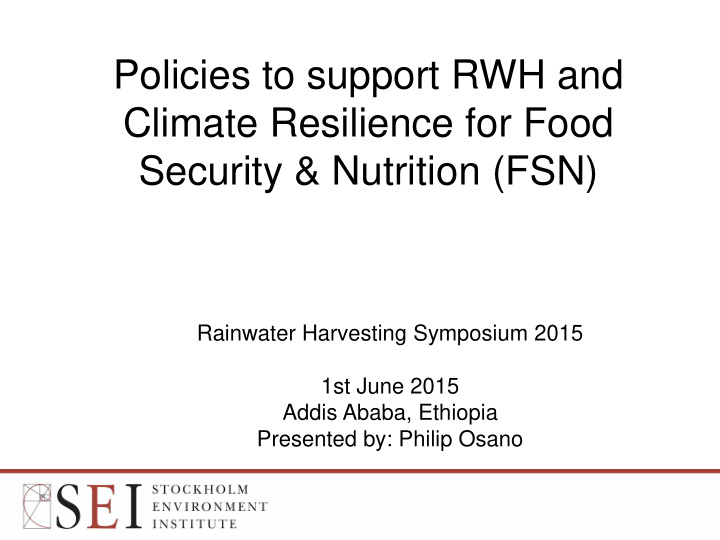



Policies to support RWH and Climate Resilience for Food Security & Nutrition (FSN) Rainwater Harvesting Symposium 2015 1st June 2015 Addis Ababa, Ethiopia Presented by: Philip Osano
I. Introduction The impacts of climate change will a ff ect food security, water availability and human health in Africa significantly ( IPCC 5 th Assessment Report )
II. RWH for Climate Resilient Agro-food systems • Rural populations – in Africa, mostly smallholders, pastoral and fisherfolk communities • Poverty – lack of access to water, sanitation leading to poor nutrition and disease burdens • Arid & semi-arid lands (ASAL) – surface run-off too low (100-300mmyr -1 ) to irrigate fields • Water harvesting (green water): a) collect run-off; b) improve infiltration of rain; c) increase storage through land, water and crop management
III. Policy Implications • Climate adaptation and mitigation : • Malabo Declaration on Accelerated Agricultural Growth and Transformation for Shared Prosperity And Improved Livelihoods Commitment to enhancing resilience of livelihoods and production systems i. ensure that, by the year 2025, at least 30% of our farm, pastoral, and fisher households are resilient to climate and weather related risks; ii. enhance investments for resilience building initiatives, including social security for rural workers and other vulnerable social groups, as well as for vulnerable ecosystems; iii. to mainstream resilience and risk management in our policies, strategies and investment plans.
III. Policy Implications • Integrated approach : co-ordination among water, food, agriculture, energy, and trade sectors o Integrate climate change into water resource management strategies o Integrate water into Climate Change strategies • Review implications of climate change to water for multiple uses (e.g. energy, agriculture etc). • Promote policy and institutional co-ordination: Example of the Nexus Approach to Planning
SEI Experience with Nexus Aim : addressing inter-connected water, energy and food development challenges at different levels, in order to enable those who govern and manage these systems to work together to meet human aspirations
Nexus – Lake Tana Basin, Ethiopia Aim : Assess impacts of different development pathways on various stakeholder groups, after accounting for interactions between sectors Issues • Development pathways • Conflicting interest and aspirations among different sectors and stakeholders • Policy frameworks at the national level; The CRGE (Climate Resilient Green Economy) - 2012 The GTP (Growth and Transformation Plan) - 2010
Nexus – Lake Tana Basin, Ethiopia Karlberg et al., 2014
Nexus – Lake Tana Basin, Ethiopia Three stories about the future • Business as usual (BAU): slow development, low adoption of new technology • National plans (Nat Plans): full adoption of technologies according to national policies • Nexus (Nexus): resolving outstanding dilemmas, new policy and innovation needs Population increase same in all scenarios
Nexus – Lake Tana Basin, Ethiopia Karlberg et al., 2014. Food-Energy-Environment Nexus in Ethiopia. Water Alternatives 8(1): 710-734
Nexus – Lake Tana Basin, Ethiopia • Indirect and direct links between energy transitions and agricultural transformations • Resource competition between sectors: land and water cannot be substituted for food production • Climate change: dictates transformation of energy and agricultural sectors • Policy / planning implementation + new investments: need for cross-sector dialogue underpinned by quantitative assessments Karlberg et al., 2014. Food-Energy-Environment Nexus in Ethiopia. Water Alternatives 8(1): 710-734
THANK YOU!!!!
Recommend
More recommend